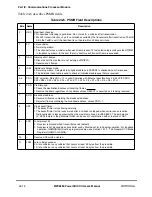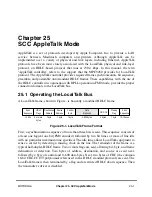
25-4
MPC8260 PowerQUICC II UserÕs Manual
MOTOROLA
Part IV. Communications Processor Module
5. Clear TEND for default operation.
6. Set TPP to 0b11 for a preamble pattern of all ones.
7. Set TPL to 0b000 to transmit the next frame with no synchronization sequence and
to 001 to transmit the next frame with the LocalTalk synchronization sequence. For
example, data frames do not require a preceding synchronization sequence. These
bits may be modiÞed on-the-ßy if the AppleTalk protocol is selected.
8. Clear TINV and RINV so data will not be inverted.
9. Set TSNC to 1.5 bit times (0b10).
10. Clear EDGE. Both the positive and negative edges are used to change the sample
point (default).
11. Clear RTSM (default).
12. Set all other bits to zero or default.
13. Set ENT and ENR as the last step to begin operation.
25.4.2 Programming the PSMR
Follow these steps to program the protocol-speciÞc mode register:
1. Set NOF to 0b0001 giving two ßags before frames (one opening ßag, plus one
additional ßag).
2. Set CRC 16-bit CRC-CCITT.
3. Set DRT.
4. Set all other bits to zero or default.
For the PSMR deÞnition, see Section 21.8, ÒHDLC Mode Register (PSMR).Ó
25.4.3 Programming the TODR
Use the transmit-on-demand (TODR) register to expedite a transmit frame. See
Section 19.1.4, ÒTransmit-on-Demand Register (TODR).Ó
25.4.4 SCC AppleTalk Programming Example
Except for the previously discussed register programming, use the example in
Section 21.14.6, ÒHDLC Bus Protocol Programming.Ó
Summary of Contents for MPC8260 PowerQUICC II
Page 1: ...MPC8260UM D 4 1999 Rev 0 MPC8260 PowerQUICC II UserÕs Manual ª ª ...
Page 66: ...lxvi MPC8260 PowerQUICC II UserÕs Manual MOTOROLA ...
Page 88: ...1 18 MPC8260 PowerQUICC II UserÕs Manual MOTOROLA Part I Overview ...
Page 120: ...2 32 MPC8260 PowerQUICC II UserÕs Manual MOTOROLA Part I Overview ...
Page 138: ...Part II iv MPC8260 PowerQUICC II UserÕs Manual MOTOROLA Part II Configuration and Reset ...
Page 184: ...4 46 MPC8260 PowerQUICC II UserÕs Manual MOTOROLA Part II ConÞguration and Reset ...
Page 202: ...Part III vi MPC8260 PowerQUICC II UserÕs Manual MOTOROLA Part III The Hardware Interface ...
Page 266: ...8 34 MPC8260 PowerQUICC II UserÕs Manual MOTOROLA Part III The Hardware Interface ...
Page 382: ...10 106 MPC8260 PowerQUICC II UserÕs Manual MOTOROLA Part III The Hardware Interface ...
Page 392: ...11 10 MPC8260 PowerQUICC II UserÕs Manual MOTOROLA Part III The Hardware Interface ...
Page 430: ...Part IV viii MOTOROLA Part IV Communications Processor Module ...
Page 490: ...14 36 MPC8260 PowerQUICC II UserÕs Manual MOTOROLA Part IV Communications Processor Module ...
Page 524: ...17 10 MPC8260 PowerQUICC II UserÕs Manual MOTOROLA Part IV Communications Processor Module ...
Page 556: ...18 32 MPC8260 PowerQUICC II UserÕs Manual MOTOROLA Part IV Communications Processor Module ...
Page 584: ...19 28 MPC8260 PowerQUICC II UserÕs Manual MOTOROLA Part IV Communications Processor Module ...
Page 632: ...21 24 MPC8260 PowerQUICC II UserÕs Manual MOTOROLA Part IV Communications Processor Module ...
Page 652: ...22 20 MPC8260 PowerQUICC II UserÕs Manual MOTOROLA Part IV Communications Processor Module ...
Page 668: ...23 16 MPC8260 PowerQUICC II UserÕs Manual MOTOROLA Part IV Communications Processor Module ...
Page 758: ...27 28 MPC8260 PowerQUICC II UserÕs Manual MOTOROLA Part IV Communications Processor Module ...
Page 780: ...28 22 MPC8260 PowerQUICC II UserÕs Manual MOTOROLA Part IV Communications Processor Module ...
Page 874: ...29 94 MPC8260 PowerQUICC II UserÕs Manual MOTOROLA Part IV Communications Processor Module ...
Page 920: ...31 18 MPC8260 PowerQUICC II UserÕs Manual MOTOROLA Part IV Communications Processor Module ...
Page 980: ...A 4 MPC8260 PowerQUICC II UserÕs Manual MOTOROLA Appendixes ...
Page 1002: ...Index 22 MPC8260 PowerQUICC II UserÕs Manual MOTOROLA INDEX ...
Page 1006: ......
















































